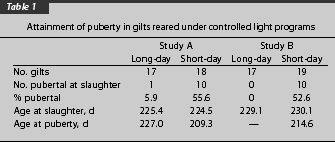What’s your interpretation? — May and June, 1998
What’s your interpretation? |
Photoperiod and seasonal productivity in swine
This figure shows a seasonal pattern of insulin-like growth factor I
(IGF-I) in blood plasma in male pigs raised in a light-proof building with
identical temperature and diets.  Pigs in the natural photoperiod
had minimum light (7 hours and 51 minutes) in December and maximum light
(16 hours and 35 minutes) in June. Pigs in the reverse photoperiod had a
shift of 6 months with minimum light in June and maximum in December. The
light program was adapted once a week. What can you tell from the figure?
Pigs in the natural photoperiod
had minimum light (7 hours and 51 minutes) in December and maximum light
(16 hours and 35 minutes) in June. Pigs in the reverse photoperiod had a
shift of 6 months with minimum light in June and maximum in December. The
light program was adapted once a week. What can you tell from the figure?
Phenomenon
A seasonal pattern of productivity in domestic swine has been reported throughout the world. Reproductive and growth performance is low during summer months and high during winter months. Puberty of gilts is delayed during summertime.
The figure on the front cover demonstrates a light-dependent seasonal pattern of IGF-I levels in male pigs exposed to one of two light programs.1 The highest IGF-I concentrations occurred under decreasing daylength (October in the natural photoperiod and April in the reverse photoperiod). Lower IGF-I concentrations were observed under increasing daylength (March in the natural photoperiod and October in the reverse light program). The IGF-I concentrations were highly correlated with feed intake and testosterone concentrations.1
The effect of light duration on the attainment of puberty in gilts was
studied in two replications (studies A and B, Table 1) of two light
programs (long day and short day).2 Study A began in March, and
study B began in September. Beginning at 57 days of age, gilts received
12 hours of light (L) and 12 hours of darkness (D). Under the long-day program,
light was increased each week by 10-15 minutes for 12 weeks to reach a duration
of 14.5 hours L:9.5 hours D. Photoperiod was then decreased 10-15 minutes
per week for 12 weeks to return to 12L:12D by the end of the study. Pigs
under the short-day program received the reverse photoperiod: a photoperiod
decreased by 10-15 minutes each week for 12 weeks to reach 9.5L:14.5D per
day, and then increasing light weekly for 12 weeks to return to 12L:12D.
Gilts received the same diets and were housed at the same ambient temperature.
Photoperiod was a major factor responsible for the delay in puberty (Table
1).
of two light
programs (long day and short day).2 Study A began in March, and
study B began in September. Beginning at 57 days of age, gilts received
12 hours of light (L) and 12 hours of darkness (D). Under the long-day program,
light was increased each week by 10-15 minutes for 12 weeks to reach a duration
of 14.5 hours L:9.5 hours D. Photoperiod was then decreased 10-15 minutes
per week for 12 weeks to return to 12L:12D by the end of the study. Pigs
under the short-day program received the reverse photoperiod: a photoperiod
decreased by 10-15 minutes each week for 12 weeks to reach 9.5L:14.5D per
day, and then increasing light weekly for 12 weeks to return to 12L:12D.
Gilts received the same diets and were housed at the same ambient temperature.
Photoperiod was a major factor responsible for the delay in puberty (Table
1).
Mechanisms
Photoperiod may govern the production of melatonin to influence reproduction. Melatonin is a hormone secreted from the pineal gland during the dark hours of the light-dark cycle in many mammals. The direction of its nocturnal increase in serum signals changes in daylength to the neuroendocrine system. The link between melatonin and seasonal breeding is the GnRH (gonadotropin-releasing hormone) pulse generator, which regulates pituitary LH (luteinizing hormone) secretion. Oral administration of melatonin has reduced age of puberty in gilts.
Implications
Seasonal reductions in productivity of swine may be decreased or minimized if photoperiod is considered in combination with decreasing temperature and increasing nutrient density in diets during the summertime.
References
1. Weiler U, Claus R, Dehnhard M, Hofäcker S. Influence of the photoperiod and a light reverse program on metabolically active hormones and food intake in domestic pigs compared with a wild boar. Can J Anim Sci. 1996; 76:531-539
2. Paterson AM, Pearce GP. Attainment of puberty in domestic gilts reared under long-day or short-day artificial light regimens. Anim Reprod Sci. 1990; 23:135-144